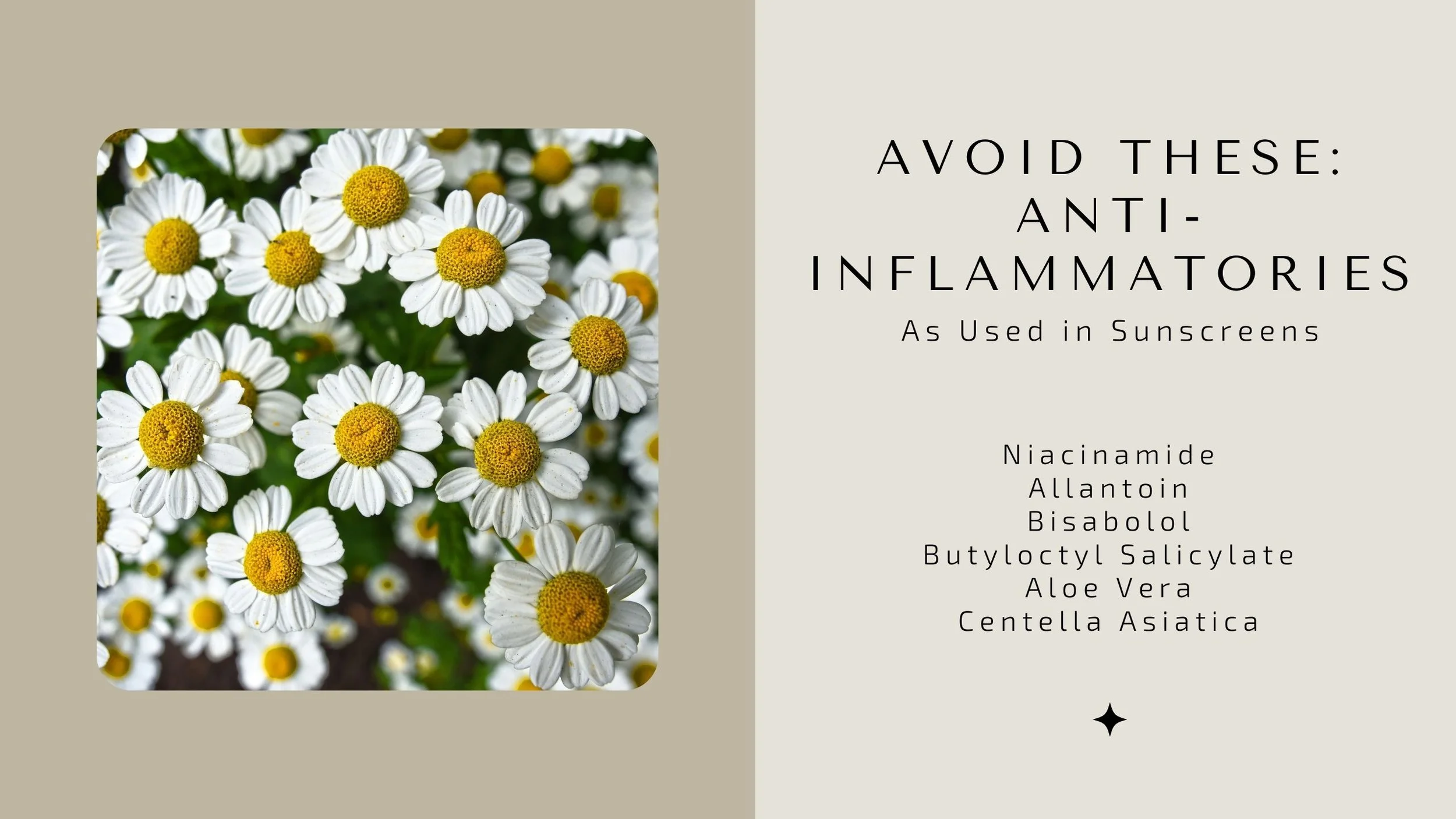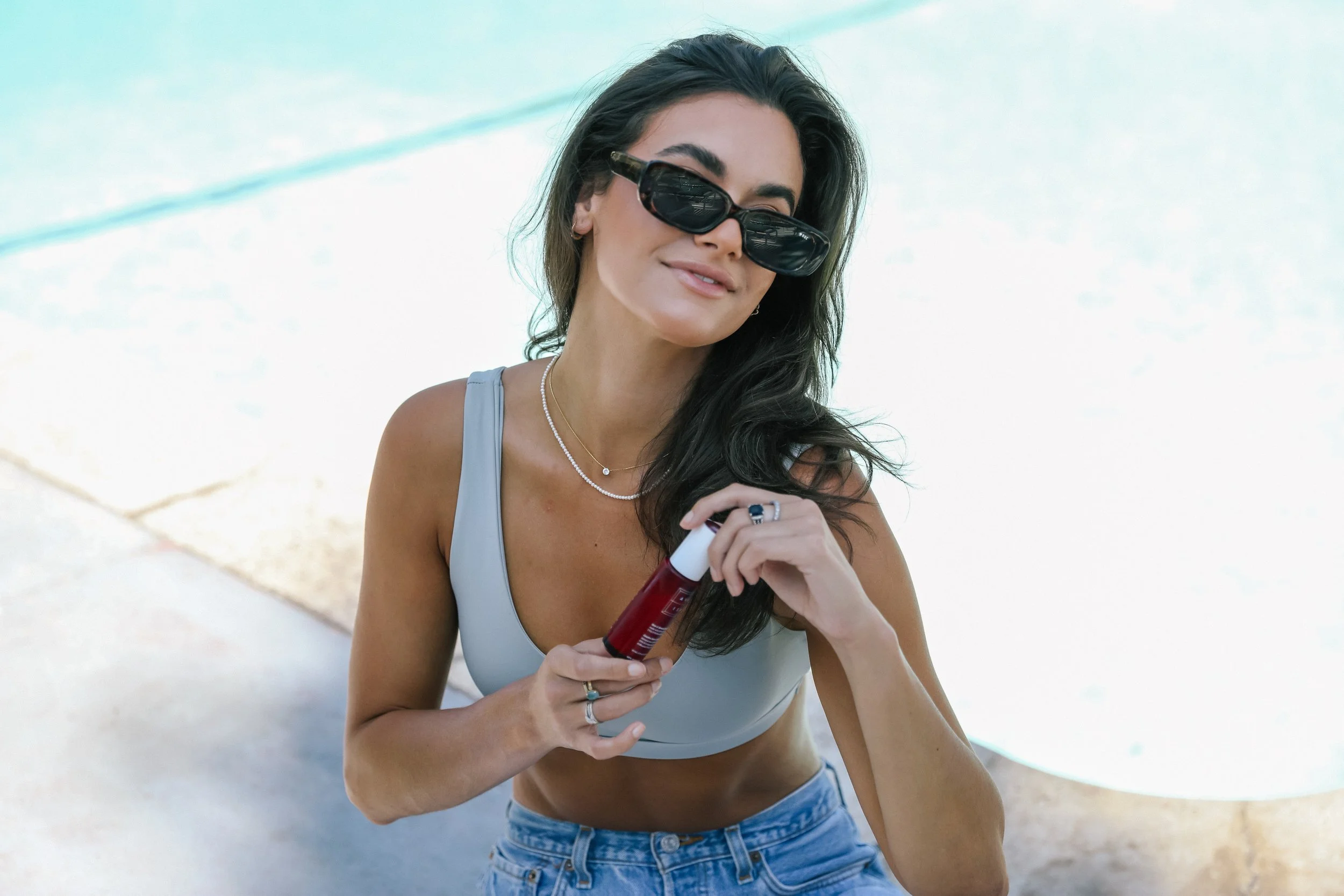Can Sunscreens with 'Skincare Benefits' be a bad thing? The pros and cons of using anti-inflammatories and antioxidants in sunscreen formulations.
Sunscreens with Skincare Benefits. Not all skincare benefits are created the same.
The good (anti-oxidants), the best (actual UV filters) and the bad (anti-inflammatories).
People are finally getting on board with the message that sunscreens are the number # 1 piece of skincare that everyone should use, every single day. Sunscreens are positioned to have the biggest potential impact on the health of your skin by preserving it against UV damage. As the interest in skincare as a category has also grown- people are becoming more ingredient savvy and willing to treat their skin. It makes sense that sunscreens would evolve to go beyond pure UV protection and have additional skincare benefits. On the surface, how could additional skincare actives in a sunscreen ever be a bad thing? Sunscreens with actives like niacinamide, allantoin, and centella asiatica have become quite popular and are marketed as multifunctional products that make life easier. However, it is important to differentiate between the different type of skincare actives and their roles- namely anti-inflammatories, anti-oxidants and UV filters. In this blog, we are going to examine how the specific category of anti-inflammatories can artificially impact a SPF in a way that can actually be harmful. We’ll take a look at why anti-oxidants are different and share our overall formulation philosophy when it comes to combining anti-inflammatories, anti-oxidants and UV filters in sunscreens and adjunctive skincare.
The Good: Anti-Oxidants in Sunscreens
Let’s start with the positive. There is a reason why the industry does not use the term sunblock anymore. It was misleading. Your black jeans can block sunlight in a way that your sunscreen cannot. We commonly speak about sunscreens that use an adequate amount of filters preventing 97-98% of UVB light from reaching the skin in a harmful way. The percentage of UV light that does hit the skin can still cause sun damage. Anti-oxidants are helpful in repairing this damage and they can either be used in your sunscreen formula or used in an ancillary product like a moisturizer or corrective product. They do not impact testing results for a sunscreen for either in-vivo results (results from testing on a person) or in-vitro results (results from testing on a piece of glass). We’ve historically not used anti-oxidants that are ‘delicate’ and have stability issues in sunscreens like L-ascorbic acid. The sun is in the general sense a destabilizing force and creates enough complex chemistry in the skin without adding an anti-oxidant that can breakdown and create their own free radicals. We’ve used Norwegian Spruce extract as a very stable anti-oxidant before in our Cyberderm Simply Zinc’s. We’ve also used a synthetic anti-oxidant called Micah in our Ava Isa Sun-è-Serum Drops SPF 35. It is technically an ante-oxidant in that it prevents free radical creation as opposed to scavenging existing ones.
The Best: UV Filters
It’s sunscreen season, especially on social media platforms. It’s quite common now to show a shelf full of sunscreen of formulas but there still seems to be a misunderstanding about the role that UV filters can have. Zinc oxide remains the current best choice in North America for true broad spectrum protection, especially against long wave UVA light. However, it requires the use of large concentrations (as close to a concentration of 25%) as possible and there is a good linear relationship between the % concentration of zinc oxide used and the degree of protection in the UVA range as measured by the UVA Protection Factor.
When it comes to your sunscreen, the quality of your protection is still the most important factor in choosing your SPF. We would argue it’s more important than the quantity of sunscreen that you use. People have taken to measuring out their sunscreen by the 1/4-1/2 tsp. or using the 2-3 finger method for sunscreen application. However, the quantity of sunscreen is secondary to the UV filters that are included in the formula and the level of UVA protection that you are getting. So often, we will see people refer to their favourite sunscreen with no mention of what their sunscreen contains. It’s a common refrain that the “dose is in the poison” but you could argue the “dose is in the benefit” as well. Most people would never take a drug like a painkiller and not know the drug active and the concentration. We recommend people approach their sunscreen in a similar way. Does your chosen formula have ingredients that protect against UVA or just UVB light? Does your chosen formula have a high enough concentration of the active to actually protect? It is a red flag if you can either not read the ingredient list (i.e. it’s in a different language that you can not read) or it does not promote the concentration of your actives. Your sunscreen with skincare benefits should list and promote the concentration of the UV filter as it’s first main benefit. All other ingredients should be listed as a secondary consideration. Finally, a sunscreen should never replace a UV filter with anti-oxidants or anti-inflammatories. You can actually harm your skin if you use a product that uses a lower amount of a UV filter but a high degree of anti-oxidants or anti-inflammatories.
The Bad: Anti-Inflammatories
In what world can niacinamide be a bad thing for your skin? We’re shocked to say it too but let’s make it clear: anti-inflammatories that have known anti-redness properties do not belong in your sunscreens. Sunscreens now a days are full of them though. Turn your sunscreen bottle around and read the ingredients. Does it contain; aloe vera, allantoin, bisabolol (chamomile derivative), butyloctyl salicylate, or niacinamide? Many anti-oxidants can have an anti-inflammatory component to how they work but we’re really focusing on anti-inflammatories that have known and are marketed as anti-redness agents. How do they impact your sunscreen?
The Sun Protection Factor of your sunscreen is tested using an in-vivo method (on person) that correlates the degree of redness in the skin to the degree of UVB and some short wave UVA protection of your sunscreen. Your skin responds to these wavelengths of UV light by getting red and this is part of what is involved in sunburn. Anti-inflammatories to different degrees will mute skin redness. For in-vivo tests, sunscreens that feature large concentrations of anti-inflammatories can make it difficult to decipher whether UV light was actually attenuated (blocked) or was the body’s response in the form of skin redness just minimized. If it’s the latter then the skin was still damaged from UV light, but the warning sign was silenced.
You can see how potentially damaging this situation might be. For one, the labelled SPF might be artificially high and give a false sense of protection. This can lead to an increase of risky sun behaviour as someone might not take other sun safe precautions like re-apply, seek shade or wear sun protective clothing. Ultimately your skin is being damaged.
As a formulator, there are red flags when considering whether to use an ingredient in your sunscreen formulation. Many anti-inflammatories like butyloctyl salicylate or bisabolol are marketed as SPF boosters by raw material suppliers. In their own clinical studies, they have shown an increase in SPF and Persistent Pigment Darkening (in-vivo version of UVA test) by up to 60%. However, when they qualify these results as only occurring during in-vivo testing and not in-vitro, that is an indicator that they are not reducing or attenuating UV light but working through the means of reducing skin redness. We have seen this when we have sent a commercially available sunscreen that had a labelled SPF of 40 and a PA rating of +++ (or an in-vivo UVA of 8-16). When we had it tested at a 3rd party lab, using a methodology that does not rely on skin redness or darkening but measures actual UV attenuation, it received an SPF 4 and a UVA PF of 4. You can imagine how a consumer might change their behaviour if they thought they were using a sunscreen with a SPF of 4 versus 40.
Butyloctyl salicylate is a unique ingredient in that it can improve the photostability of some soluble organic ingredients like Avobenzone and potentially help increase the efficiency of UV filters. However, it is also part of the salicylate family that like Aspirin reduces erythema substantially. It also seems like it might have some filter like properties like octyl salicylate but is not recognized by the FDA as a UV filter. One could argue that it’s inclusion in a mineral sunscreen would mean it’s not an ‘all-mineral’ one. It’s very often included in sunscreen formulas in material concentrations of up to 10%. From our view point, it’s also less than 500 Daltons in terms of molecular weight and there is good reason to think it would be absorbed by the body. This potential for permeation would also disqualify its use in our formulas. However, it’s impact on the SPF and the fact that it makes it challenging to discern between protection and reduction in skin redness means that we would avoid it.
The Take-Away
Your sunscreen should never use less of a UV Filter because they included anti-inflammatories or even anti-oxidants. Anti-oxidants are helpful in a sunscreen formula but they do not replace a UV filter. Anti-inflammatories make it challenging to distinguish between real protection and minimizing skin redness. They may provide a false sense of protection to consumers. Most damning of all, they are not preventing UV damage to the skin. They should not be in a sunscreen formula for that reason. While we love a multi-functional product, sunscreens and ingredients like niacinamide, aloe vera, bisabolol and more are a hard pass for us.


